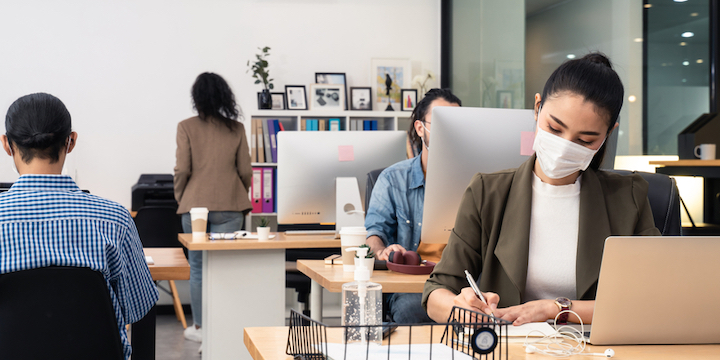How to limit the transmission of covid indoors? Researchers at the Massachusetts Institute of Technology (MIT) have asked the question. In a study they publish in the scientific journal PNAS on April 13, they establish a “good practice guide“to reduce the risk of contamination.
Their guidelines suggest setting a time limit for exposure, measured by the number of people, the size of the confined space, whether or not masks are worn, and the rate of natural and mechanical ventilation.
Diamond Princess, because of Ningbo, choir …
To establish this guide, the researchers relied on well-known and already well-studied examples since the start of the health crisis: the Diamond Princess cruise liner, the Ningbo bus in China, in which an asymptomatic patient infected a third party. passengers, or the Skagit Valley Choir in Washington State, where 86% of the participants were infected during a two-hour rehearsal.
Also read: Home, restaurant, bar… what are the places most at risk of covid contamination?
Above all aerial transmission
The researchers then built mathematical models to find out how long it takes for a new person to contract the virus in an enclosed space if an infected person enters it.
Their analysis is based on the fact that airborne transmission of covid, via tiny droplets that remain airborne for long periods of time, plays a major role in the spread of covid.
Without a mask, these droplets are more numerous than with. And their numbers increase if people talk, sing or eat.
Calculate your risk online
According to these models, general rules such as the two-meter distance rule or that of a maximum gauge do not reflect the full picture of the risk in a given confined space. Time must also be taken into account as a primary variable.
In order for their models to apply to classrooms, restaurants, places of worship, offices, airliners for example, they created a website, indoor-covid-safety.herokuapp.com, which allows you to calculate the maximum time to spend in each place. Other variables come into play, such as the activity practiced (singing, speaking, exercising, etc.) or the variant concerned, knowing that the British variant is 60% more contagious than the historical strain.
At the restaurant, two hours for 10 people
For example, a classroom full of kids under 15 who talk but wear a mask should be safe for 25 people for 38 hours with the British variant.
In a restaurant where adults aged 15 to 64 are talking without a mask: the space would be safe for 10 people for two hours but for 25 people for 51 minutes and for 100 people for only 15 minutes.
Finally, a church where people over 65 sing without a mask is safe for 10 people for seven minutes, for 25 people for four minutes, and for 100 people for only two minutes.
 Cherry tomatoes contaminated with salmonella: 92 sick and 1 dead
Cherry tomatoes contaminated with salmonella: 92 sick and 1 dead  A better coaching method can make a person grow
A better coaching method can make a person grow  What is the method to prevent diabetes in children?
What is the method to prevent diabetes in children?  What are the effective factors in causing stomach ulcers?
What are the effective factors in causing stomach ulcers?  Why do embarrassing memories seem to appear at night?
Why do embarrassing memories seem to appear at night?  The amazing link between SARS-CoV-2 infection and newly started diabetes
The amazing link between SARS-CoV-2 infection and newly started diabetes  WHO says monkey pox is not a global emergency right now
WHO says monkey pox is not a global emergency right now  Single cell RNA sequencing uncovers new mechanisms of heart disease
Single cell RNA sequencing uncovers new mechanisms of heart disease  Hepatitis of unknown origin: 3 new deaths and 228 cases worldwide
Hepatitis of unknown origin: 3 new deaths and 228 cases worldwide 